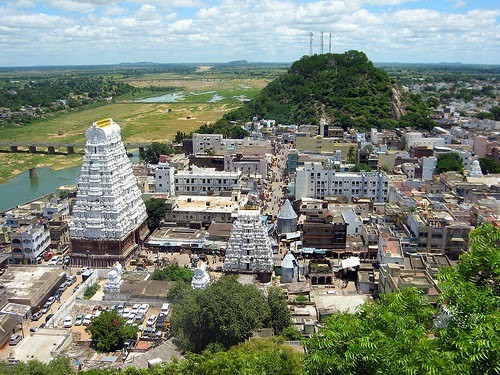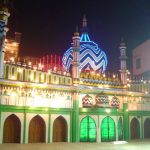This is the first in the five part Shiva series of articles that will be published in this week of Sravana Month. To start with we present the Vayu (air) linga temple based in south Indian temple town called Kalahasthi (just 50 kms from Tirupati).
Lord Shiva is the most famous Hindu God and one of three Gods of Hindu Trinity, Brahma, Vishnu, Maheswara. One can call him by any name Lord Shiva, Maheshwara, Rudra,Kailash, Shambu, Shiv,Shankar, Bhole Nath, Mahadev and Bhairav he is the epitome of kindness. Though he is associated with destruction and annihilation because of his “Third eye” at the same time he is also associated with the artistic dance forms as “Nataraja”.
Unlike Lord Vishnu, who is worshipped in various forms, Shiva is worshipped in the form of Linga. Linga symbolizes the outward aspect of formless. The Shiva Linga is a symbol of the formless power. The Linga is a physical manifestation of the Supreme Being,
Representing the five elements of life, Pancha Bhootalu – Agni (Fire), Vayu (Air), Jal (Water), Prithvi (Earth) and Akash (Space), temples have been dedicated to Shiva with Lingams that represent each of these elements as the supreme power.
Sri Kalahastheeswara Temple in Kalahasthi, Andhra Pradesh has the Vayu Lingam. It represents Air.
Ekambareswarar Temple in Kanchipuram, Tamil Nadu has the Prithivi Lingam. It represents Earth.
Jambukeshwarar Temple in Thiruvanaikaval near Trichy, Tamil Nadu is home to the Jambu Lingam. It represents Water.
Arunachaleswara Temple in Thiruvannamalai, Tamil Nadu is the abode of the Agni Lingam. It represents Fire.
Thillai Nataraja Temple in Chidambaram, Tamil Nadu is home to the Akasha Lingam. It represents Space.
Sri Kalahastheeswara Temple
Sri Kalahastheewsara Temple, Kalahasthi is located in Andhrapradesh on the banks of river Swarnamukhi. It is situated very near to Tirupathi and is one of the Panchabhoota stalams.
Kalahasthi is known as the “Kailas of South” and according to the ancient Tamil scriptures the temple is more than two thousand years old and the small river on whose banks it sits is said to be the ‘Ganges of the South” with Himalayas considered as the abode of Lord Shiva, the Kailas. Kalahasthi is also considered the Rahu- kethu Kshetra where the prayers are offered to appease them.

The presiding diety Srikalahasteeshwara is worshipped as Vayulingeswara. This ancient temple is dedicated to Lord Shiva is one of the pancha bhoota sthalas (temples celebrating Shiva as the embodiment of the primary elements) – ‘Air’ being the element in case of Srikalahasti. The ‘lingam’ in this temple is ‘swayambhu’ (self-manifiested) and is called ‘Sri Kalahasteeshwara Swamy, named after three devotees – sri (spider), kala (serpant), hasti (elephant) who worshipped Shiva with unflinching devotion and attained mukthi (salvation) at this place.
The vast west facing Kalahastiswara temple is built adjoining a hill, and on the banks of the river Swarnamukhi. At some points, the hill serves as the wall of the temple. The temple prakarams follow the contour of the adjoining hill and hence the temple plan is rather irregular. North of the temple is the Durgambika hill, south is the Kannappar hill and east is the Kumaraswamy hill.
Legend
It is said that the spider wove a web above the lingam to protect it from sun and the rain. The elephant would get water with its trunk and give bath to the lingam and the snake would also worship the Lord. One day the snake found bilva leaves and water near the Lord. Thinking that someone was trying to harm the Lord, The Snake surrounded the Lord to protect. When the elephant came to worship, the snake got into the trunk. Unable to bear the pain the elephant dashed against the lingam killing the snake and the elephant also died at the feet of the lingam. Lord Shiva gave mukthi to his three devotees at this place.

The main lingam is in the shape of an elephant trunk with tusks on each side and a figure of a spider at the bottom. If you look at the linga from the top it looks like a snake with hoods. The spider is ‘Sri’, the snake ‘Kala’ and the elephant ‘Hasti’. The three names combined together is the name Srikalahasti. As the legend goes, the spider was Vishwakarama’s son Oornanabha, who was replicating Brahma – the creator’s job, and annoyed Brahma cursed him to become a spider. The snake was once cursed by Shiva himself. The elephant was a Deva cursed by Parvathi when he intruded their privacy. The Shivalinga at Srikalahasti is an amalgamation of these three animals.
Legends associated with Temple
Thinna is another devotee, who attained salvation through his unstinted devotion. He is none other than Arjuna of Mahabharatha who asked Shiva for moksha and was born as Thinna the hunter, to attain the same. It is said that Sri Kannappa (Thinna) sacrificed his eyes to the Lord and attained mukthi. Since Thinna offered his eyes to Lord Shiva, he is called ‘Kannappa’ – ‘kannu’ being the Telugu word of eye.

At Sri Kalahasti, Lord Shiva tested the unshakable devotion of Kanna (Later became Bhaktha Kannappa) before the sages gathered at SriKalahasti. With his divine power, Lord Shiva created a tremor and the roof tops of the temple began to fall. All the sages ran away from the scene except Kannappa who covered the linga with his body to prevent it from any damage.
Also Read : Importance of Rudrabhishekam in the Month of Shiva
In another incident, Kannappa plucked out one of his eyes and placed in the eye of Linga which was oozing with blood and tears. When the tears and the blood were still trickling from another eye, Kannappa decided to remove his second eye and placed one of his feet on the spot of the right eye of the Shiva Linga. Before he could pull out his second eye with the arrow, Lord Shiva appeared and restored his eye while granting him a boon to occupy a place close to him.
Architecture
The history of Srikalahastivara temple can be traced back atleast to the 7th century A.D. as evidenced by the Tamil sacred literature Devaram and Tiruvacakam. The Nayanars sung its glory to their heart’s content. As the region in which the temple of Srikalahastivara formed part of the Chola empire. The three lofty Gopurams of the temple are remarkable for their architecture. A huge hundred pillared Mantapam is another important part of this shrine.

When one enters the temple town of Srikalahasti, what strikes instantly is the intricate structures reflecting our culture in all its grandeur. The temple of Srikalahasti has four major entrances each with a huge tower. Sri Krishnadevaraya built a huge gopuram in 1516, a few feet away from the entrance to the temple. The entrance to the temple is crowned with a smaller tower. There is an underground Ganapati shrine in the outer prakaram, while in the innermost prakaram are the shrines of Shiva and Parvati. This ancient gopuram over the main gate, which is 36.5 meters (120 feet) high and the entire temple is carved
Rahu Ketu Pooja
The main linga is untouched by human hands, even by the chief priest. The sight of the navagraha kavacha adorned on the linga relieves the devotee of the evil effects of the nine planets. This temple is attributed to the planets Rahu & Kethu. According to the legends, a pilgrimage to Sri Kalahasti on a Saturday or Tuesday will mitigate the evil effects of Rahu & Kethu. ‘Rahu Kethu Dosha Nivarana Pooja’ performed during the Rahu kala relives one from the evil effects.
Srikalahasti mahathyam:
The Telugu poet Dhoorjati in his ‘Srikalahasti Mahathyam’ has many interesting stories beautifully depicted. The Carnatic leged Muthswamy Dikhsitar has sung the glories of the temple.
Importance of Darshan:
The lamp inside the sanctum that is constantly flickering, despite the lack of air movement inside, can be seen. The flames from several ghee lamps flickers, as if blown by the moving air. When all the lamps in the sanctum glow steadily, one can notice two lamps flickering now and then, proving the Lord’s inhalation and exhalation. Thus a visit to Sri Kalahasti is equal to visiting other holy places of great importance in India as among the Pancha Bootha Lingams, Srikalahastheeshwara Linga is worshipped as Vayulingeshwara
Must Read: Zodiac predictions for the coming week of July 30- August 5









